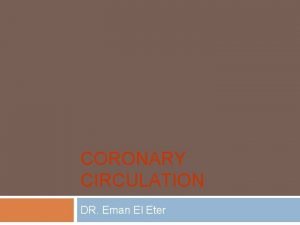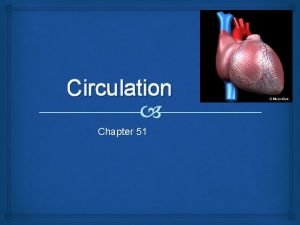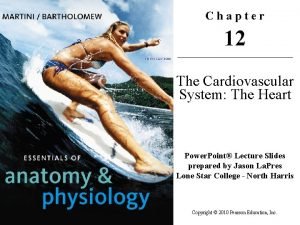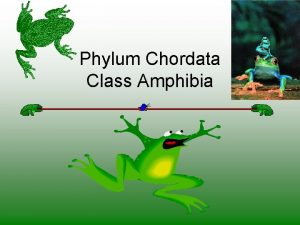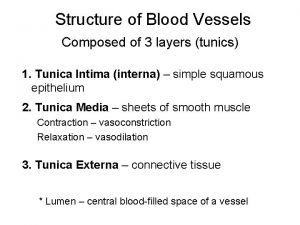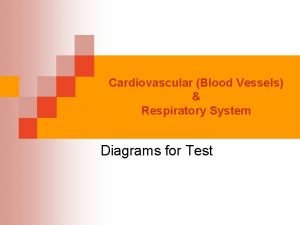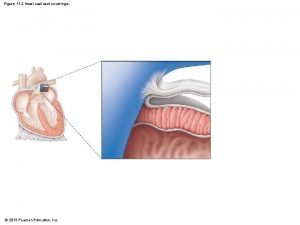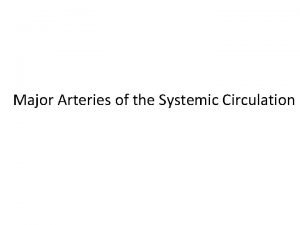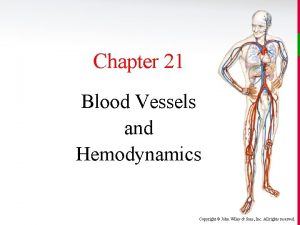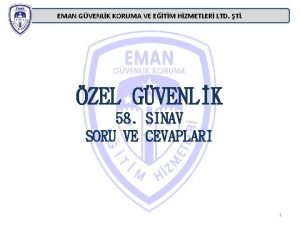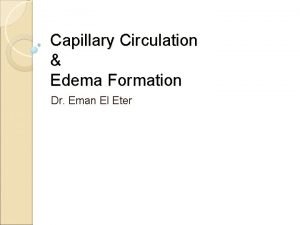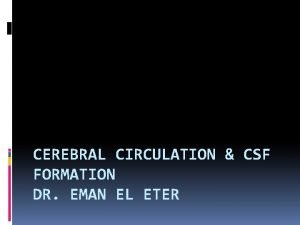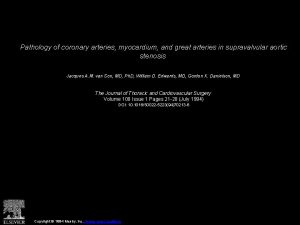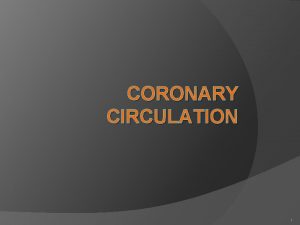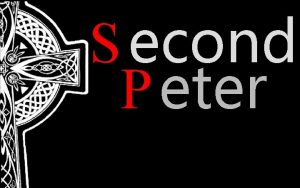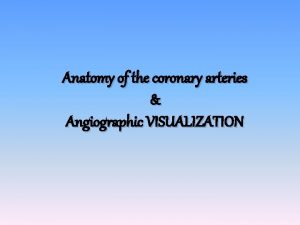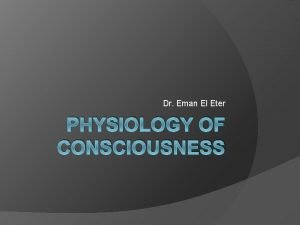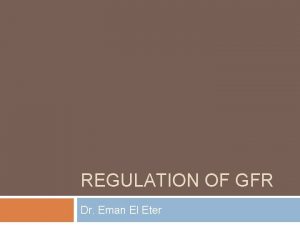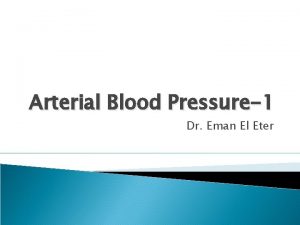CORONARY CIRCULATION DR Eman El Eter Coronary Arteries















- Slides: 15

CORONARY CIRCULATION DR. Eman El Eter

Coronary Arteries The major vessels of the coronary circulation are: 1 - left main coronary that divides into left anterior descending and circumflex branches, 2 - right main coronary artery. The left and right coronary arteries originate at the base of the aorta from openings called the coronary ostia located behind the aortic valve leaflets.

Coronary blood flow: The right coronary artery has a greater flow in 50% of population. The left has a greater flow in 20%. Flow is equal in 30%. Coronary blood flow at rest in humans = 250 ml/min (5% of cardiac output) Venous blood: Most of the venous drainage of the heart returns through the coronary sinus and anterior cardiac veins.

What is the function of coronary arteries? The coronary arteries supply blood flow to the heart, and when functioning normally, they ensure adequate oxygenation of the myocardium at all levels of cardiac activity. Constriction and dilation of the coronary arteries, governed primarily by local regulatory mechanisms, regulate the amount of blood flow to the myocardium in a manner that matches the amount of oxygen delivered to the myocardium with the myocardial demand for oxygen.

Coronary blood flow during Cardiac cycle

Coronary blood flow during Cardiac cycle Most of the coronary flow occurs during diastole. Extravascular compression during systole markedly reduce coronary flow. At low coronary perfusion pressures, the endocardium is more susceptible to ischemia. This is because of extravascular compression. Tachycardia shortens coronary filling time during diastole – this is particularly significant in patients with coronary artery disease where coronary flow is reduced.

Factors Affecting Coronary Blood Flow 1 - Autoregulation: Flow is tightly coupled to oxygen demand. This is necessary because the heart has a very high basal oxygen consumption (8 -10 ml O 2/min/100 g). In non-diseased coronary vessels, whenever cardiac activity and oxygen consumption increases, there is an increase in coronary blood flow (active hyperemia) that is nearly proportionate to the increase in oxygen consumption. Good autoregulation between 60 and 200 mm. Hg perfusion pressure helps to maintain normal coronary blood flow whenever coronary perfusion pressure changes due to changes in aortic pressure.

Factors affecting coronary blood flow, cont. , …. 2 - Adenosine : An important coronary dilator that mediates autoregulation. 3 - Nitric oxide: coronary vasodilator.

Factors affecting coronary blood flow, cont. , …. 4 - Nervous regulation: Activation of sympathetic nerves innervating the coronary vasculature causes only transient vasoconstriction mediated by a 1 -adrenoceptors. This brief vasoconstrictor response is followed by vasodilation caused by enhanced production of vasodilator metabolites (active hyperemia) due to increased mechanical and metabolic activity of the heart resulting from b 1 -adrenoceptors activation of the myocardium. Therefore, sympathetic activation to the heart results in coronary vasodilation and increased coronary flow due to increased metabolic activity (increased heart rate, contractility) despite direct vasoconstrictor effects of sympathetic activation on the coronaries.

Factors affecting coronary blood flow, cont. , …. Parasympathetic stimulation of the heart: (i. e. , vagal nerve activation) elicits modest coronary vasodilation (due to the direct effects of released acetylcholine on the coronaries). However, if parasympathetic activation of the heart results in a significant decrease in myocardial oxygen demand due to a reduction in heart rate, then intrinsic metabolic mechanisms will increase coronary vascular resistance by constricting the vessels.

What is the most vulnerable portion of the heart to ischemia? Because there is no blood flow during systole in the subendocardial portion of the left ventricle, this region is prone to ischemic damage and is the most common site of myocardial infarction.

Oxygen consumption by the heart and energy substrate At rest, O 2 consumption by beating heart = 9 ml/100 g/min. During ms. ex and other conditions increases in myocardial O 2 consumption are met by increases in CBF. O 2 consumption by the heart is determined by: Intra-myocardial tension. Contractile state of the myocardium. Heart rate. An increase in afterload causes greater increase in O 2 than an increase in preload does. This is why angina due to deficient delivery of O 2 to the myocardium is more common in aortic stenosis than in aortic regurge.

What are the physiological and clinical consequences of coronary artery disease When CAD restricts blood flow to the myocardium, there is an imbalance between oxygen supply and oxygen demand. When the oxygen supply is insufficient to meet the oxygen demand (reduced oxygen supply/demand ratio, the myocardium becomes hypoxic. This is often associated with chest pain (angina) and other clinical symptoms. Severe ischemia can lead to anoxia and infarction of the tissue. Furthermore, acute or chronic ischemia caused by CAD can impair cardiac mechanical and electrical activities leading to heart failure and arrhythmias.

What is coronary artery disease? Coronary artery disease (CAD) causes changes in both structure and function of the blood vessels. Atherosclerotic processes cause an abnormal deposition of lipids in the vessel wall, leukocyte infiltration and vascular inflammation, plaque formation and thickening of the vessel wall. These changes lead to a narrowing of the lumen (i. e. , stenosis), which restricts blood flow. Early in the disease process, the endothelial cells that line the coronary arteries become dysfunctional. Because the endothelium produces important substances such as nitric oxide that are required for normal coronary function, endothelial dysfunction can lead to coronary vasospasm, impaired relaxation, and formation of blood clots that can partially or completely occlude the vessel.

How is coronary artery disease treated? CAD results in myocardial ischemia, which leads to chest pain(angina )and cardiac mechanical and electrical dysfunction. The goal in treating CAD is to restore normal coronary perfusion, or if that is not possible, then to reduce the oxygen demand by the heart (i. e. , normalize the oxygen supply/demand ratio) so as to minimize myocardial hypoxia. In severe CAD in which one or more coronary arteries is very stenotic, some patients will have a stent implanted within the coronary artery to open up the lumen and restore blood flow. Other patients may undergo coronary artery bypass grafts in which the diseased segment is bypassed using an artery or vein harvested from elsewhere in their body (i. e. , internal mammary artery). If the coronary is occluded by a blood clot, a thrombolytic drug may be administered to dissolve the clot. Anti-platelet drugs and anticoagulants are also given to patients with CAD. However, the vast majority of CAD patients are treated with antianginal drugs that reduce the myocardial oxygen demand by decreasing heart rate, contractility, afterload or preload (e. g , . beta-blockers, calciumchannel blockers, nitrodilators, or they are treated with drugs that many prevent or reverse coronary vasospasm in patients with variant angina.
 Coronary circulation
Coronary circulation Com
Com Heart cycle animation
Heart cycle animation Coronary circulation of heart
Coronary circulation of heart Flow of coronary circulation
Flow of coronary circulation Umbilical arteries
Umbilical arteries Capillary bed labeled
Capillary bed labeled Respiratory system nasal cavity
Respiratory system nasal cavity Figure 11-6 arteries
Figure 11-6 arteries Major arteries of the ascending aorta and aortic arch
Major arteries of the ascending aorta and aortic arch Arteries of the systemic circulation
Arteries of the systemic circulation Single circulation and double circulation
Single circulation and double circulation Blood air barrier cells
Blood air barrier cells Single circulation and double circulation
Single circulation and double circulation Eman güvenlik
Eman güvenlik Eman nayyab
Eman nayyab
